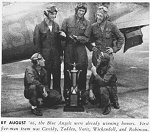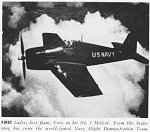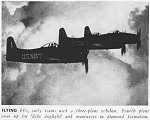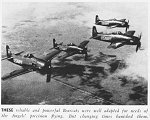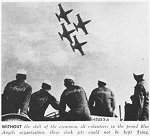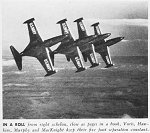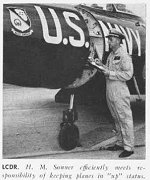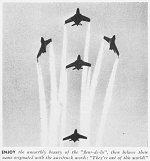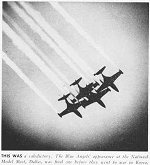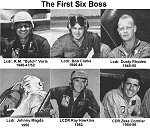|
N AVAL AVIATION NEWS |
|||||||||||||||||||||||||||||||||||||||||
|
BLUE ANGELS ARTICLE Author & Photographers: Unknown |
|||||||||||||||||||||||||||||||||||||||||
|
Eighteen minutes after the blue and gold swept-wing jets had first flashed over the crowd in a low pass; the last precision maneuver had been completed in a vertical burst of speed. With the beautiful "fleur-de-lis", another demonstration of precision flying was over. For eighteen thrill-packed minutes, more thousands of Americans had watched while these Navy pilots flying aerobatics maneuvers, at all times holding a tight, five-foot separation formation. From "eye level" to 6000 feet, at times near Mach 1, the Blue Angels exhibit techniques taught every Navy fighter pilot. In performance polished diamond-bright by practice, they use two basic formations. From the echelon and change-over rolls, the "tuck-under" break, and formation landings. In the diamond, the fly barrel rolls, loops. Reverse Cuban eight's, and the French lily breakup. After each 4-plane maneuver, a fifth pilot demonstrates maximum flight performance. The Blue Angels had come a long way since the 17th of June, 1946, when the following message was dispatched from the Naval Air Station, Jacksonville, to the Chief of Information, Washington: "Flight Exhibition Team is ready for future engagements. Team completed first public demonstration in F^F type aircraft at Southeastern Air Show, Jacksonville, on 15 and 16 June. Routine was received most enthusiastically. Team is an outstanding contribution for public information on Naval Aviation." Thus began a schedule which would see the Blue Angels averaging three to five demonstrations a month before spectators ranging from a conservative 4,000 at the Naval Academy to a record of over 2,000,000 once at New York. Since that day in 1946, members of the team had flown miles enough to encircle the earth many times. They had performed before crowds of Americans totaling well over 20,000,000. They had increased in actual numbers from four pilots and four planes, to seven pilots, seven exhibition planes, a transport plane, a maintenance officer, and 50 maintenance crewmen. They had known triumph, fame and honor as the world's best-known flight demonstration team. And they had known the tragedy of watching helplessly while a beloved leader, wounded in combat, had plunged to his death into the troubled waters of the Sea of Japan. Earlier in 1946, the Chief of Naval Operations had directed: "A . . . . Flight Exhibition Team be organized within the Naval Air Advanced Training Command to represent the Navy at air shows and similar events. LCdr. Roy M. "Butch" Voris was the man picked to lead the team, members of which were to be chosen from the Instructors' Advanced Training Unit, Jacksonville. The plane selected was the Grumman F6F Hellcat, replaced within a few months by the newer F8F's, lighter, faster, and more powerful planes. In these Bearcats, the team began to build a reputation that has never been dimmed. The original Blue Angels included, in addition to Voris who was Chief Flight Instructor of the Unit, LCdr. M. N Wickendoll, Lt. Al Taddero, and Ltjg. M. S. Cassidy. Within a short timer Lt. 'Robie' Robinson was added. Voris' tour of duty with the Team lasted from its activation in June '46 until June '47, when he was relieved by LCdr. R. A. Clarke, who led the group until he, in turn, was relieved by LCdr. R. E. 'Dusty" Rhodes in 1948. A tour of duty with the flight team has, from the beginning, been considered a normal tour of shore duty. Consequently, the personnel changes, from time to time. The team roster has included some of the Navy's best and most experienced fighter pilots, and always they are volunteers. For about two years, the Team comprised five fighter pilots flying four F8F's and an SNJ painted to represent a Jap "Zeke", together with 11 mechs. and radiomen. At this time, all the echelon maneuvers were performed by three planes. The fourth joined them to make two, two-plane sections for the Thatch weave attack on the Zero, call "Meat Ball" or "Beetle Bomb", that dove into sight for a dogfight. Always the Jap was shot down, trailing smoke and dropping a dummy, which was promptly captured. The victorious Bearcats then went into their diamond routine. The mechanics of securing several smoke flares to the Beetle Bomb and firing them by yanking the attaching wire while hurtling down in a spin, is a story from the fund of stories the are forming a Blue Angels' legend. Nor was it any easy task for the mech. stationed aft is the SNJ to throw the dummy out the rear hatch while they spun "down in flames." But somehow he always did it. Pilot replacements were LCdr. Dusty Rhodes, Lt. R. N. Thelen, Lt. Charles A. Knight and Ltjg. Wm. C. May. Even before joining the Angels, Dusty Rhodes was a well-known figure in Navy circles. A fighter pilot, he was shot down in 1942 during the Battle of Santa Cruz. Picked up by a Japanese destroyer, he spent the remainder of the war in a prison camp at Yokohama. The Angels liked the Bearcats for their loops, rolls, and Cuban 8's. Short-coupled and rugged as the Bearcats were, their stubby wings gave them as extremely rapid rate of roll. The F8F's stability at speeds even near stalling gave the pilots control on all maneuvers and inspired a maximum of confidence in their airplanes. But as early as 1949, it became evident that unless the Navy was to be presented as something less than a forward-looking branch of the national defense organization, its demonstration team would have to shift to jets before long. (Though there are people, who to this day, maintain the Bearcats were the Angels' best planes.) Panther jets of Grumman's "Cat" family were the ones chosen. And so it was that in May 1949, the Blue Angels went to the West Coast on temporary duty. Pilots were assigned to the jet transitional squadron for familiarization in the TV jet trainer. The engineering crewmen were detailed to the Pratt & Whitney jet engine school and the Grumman plant for a factory check-out in the new jets. The Panthers were a lot more airplane for the Angels to handle than the Bearcats had been. They were fast, and sensitive, so sensitive that these new jet jockeys found themselves ever-controlling all over the sky at first. Only practice at flying these planes could produce a familiarity with the delicate balance that proved so advantageous in the precision formation work that followed. During the entire period of their jet instruction, Dusty Rhodes and his Angels were carrying out their regular air show schedule in the F8's, averaging five demonstrations a month in the Bearcats in addition to their jet familiarization program. There was very little confusion in shifting alternately from one type of plane to another. By mid '49 the Blue Angels' maneuvers had become pretty much standardized. All was not smooth operation with their new jets, however. A former Angel recalls the difficulty in starting the engines in those days when the planes were away from home base and their jet starter. Even yet, a touch of embarrassment clings to the memory of their first jet show. The team was based at Corpus Christi and had gone to Pensacola for this first jet show - to be viewed by "the admiral ad his guests." One plane could mot be started and had been left at Corpus Christi, according to the story. At ShowTime in Pensacola, a second jet was balky. The crewmen tried every way known to them to start a jet engine. As a last desperate measure, they taxied one "live" jet in front of the dead one and blasted exhaust down the intake ducts, to start it. They were not successful. The show went on, with two jet aircraft! Personnel additions up to early 1950 had included Lt. Robert Longworth, Beetle Bomb pilot, Ltjg. E. F. Roth, Ltjg. George Hoskins, Lt. A. R. Hawkins and Ltjg. J. H. Robke. These men became another tight-knit team. Evidence had been growing that the Blue Angels needed an officer to precede them for each performance to take care of the many matters incident to back-stage preparation for a demonstration. Accordingly, another member was added to the team. Equipped with a two-seated jet trainer, he was directed, along with his logistics duties, to give familiarization hops to a select representation from local press, radio and television. A conservative estimate is that, inch by column inch, this has resulted in more beneficial publicity for Naval Aviation than any other one thing. Among those officers who have served in this capacity have been: Lts. F. A. Graham, R. D. Newhafer, Ed Oliphant, R.Smiegorki, E. T. Mahood, and H. A. Riedl. LCdr. John J. Magda added luster to the team's roster when he took over Blue Angel leadership early in 1950. A fighter pilot exclusively, Johnnie Magda destroyed five enemy planes in WW II Pacific carrier strikes. An experienced jet pilot, he had been a member of VF-51, the first carrier-based jet squadron in the Pacific. On July 29, 1950, a Department of Defense release was made: 'BLUE ANGELS' EXHIBITION SQUADRON ORDERED TO COMBAT READY STATUS. The Navy's "Blue Angels" jet flight exhibition team has been ordered to a combat ready status following its exhibition at the National Model Airplane Meet, Naval Air Station, Dallas, Texas, Sunday July 30. "The No. 1 aerial exhibition team of the Navy, which has thrilled spectators with its precision aerobatics and formation flying at air shows throughout the country during the last four years, will be assigned to fleet operations as an organized combat squadron. The squadron will retain the name 'Blue Angels'." Ordered to the West Coast, the Team became the nucleus of Fighter Squadron 191 aboard the carrier USS Princeton. Magda was named Commanding Officer of VF-191 and remained in command until he was killed off Korea's northeast coast near Wonsan in March 1951. He is the only Blue Angel ever to lose his life in combat. Magda Village, Whiting Field housing development, is named in his honor. At the time the Team "went to war", members were: Lts. Hawkins, Jake Robke and Ltjgs. Fritz Roth and George Hoskins, hold-overs from the previous team, ad Lt. Ralph Hanks and Ltjg. F. J. Murphy. LCdr R. L. ‘Zeke’ Cormier was the PIO, while Ltjg. R. D. Belt, engineering officer, had been directing activities of the 24 select maintenance men now necessary for upkeep of the jets. When, in late 1951, a need for the Blue Angels was re-evidenced, Adm. Wm. M. Fechteler, CNO, ordered their re-activation. The basic mission was modified from that set forth in ’46, "an exhibition team, to represent the Navy at air shows and similar events", to a team which will "demonstrate precision techniques of naval aviation to naval personnel and, if directed, to the public." With Navy fliers still fighting for their lives over Korea’s rugged hills and icy waters, the Blue Angels were assigned the mission of demonstrating tactics which they and other pilots had developed in actual combat, and had proved in practice again and again. For the second time LCdr Roy Voris was given the task of organizing the team. Ordered to the Naval Air Advanced Training Command, NAS Corpus Christi, "Butch" Voris was given his choice of personnel, with the stipulation that he could include no more than two ‘pre-Korean’ Angels. LCdr. Hawk Hawkins and Lt. Pat Murphy were those two. When Frank Graham was ordered as PIO, and H. C. MacKnight reported as Engineering Officer, two more old hands were added. Both had been Blue Angels. From volunteers from the Training Command, crewmen were selected, and three pilots t fill the complement: Lt. T. R. Jones, Ltjgs. ‘Bud Rich and D. E. Wood. The aircraft chosen for the new group was the F9F-5, a later and considerably faster version of the Panther series than the dash two of pre-Korean fame. This straight-wing, 600 mph-class dash five Grumman jet was to prove itself worthy of being the Blue Angels’ plane. Putting the Team back in business was an all-hands’ job at Corpus Christi. But all hands turned to, willingly. The first public showing at the Memphis Mid-South Navy Festival in May ’52 added about 50,000 to the millions of aviation enthusiasts who had seen the Blue Angels perform in the past. Team members are largely heavily decorated, combat experienced men. To read a list of their decorations is like reading a manual from the Medals and Awards section of BuPers. Next Angels leader, three-time Navy Cross winner, LCdr. A. R. Hawkins took over in December ’52. During WW II, Hawkins shot down 14 enemy planes while flying 154 missions in the Pacific, and was credited with materially contributing to the sinking of the 34,000-ton Japanese battleship, ISE. This all happened before his 21st birthday. He also completed 47 missions over Korea while flying VF-191 jets off the USS Princeton. It is said that he once complained that nothing very exciting had happened to him since he had reached voting age. He spoke too soon. When the F9F-6 he was ferrying to Corpus Christi in the summer of ’53 suffered longitudinal control failure and went into a mach-busting dive, he was forced to eject, through the canopy, into a rock wall of supersonic slip stream. Something under 30 minutes and 34,000 feet later, he floated down into a Mississippi cotton patch, only a few cuts and scratches, one cracked rib, and slightly frost bitten ears. He now can add to his honors that of being "Navy high speed ejection champion." The team went about accomplishing its primary mission, that of demonstrating precision techniques to naval personnel. Whenever it made appearances at air shows, it also accomplished the stimulation of interest in naval aviation. From October to December ’53, the group performed before an estimated 800,000 spectators. One of the largest crowds ever to witness a single-day air show in the history of aviation – 300,000 persons – watched breathlessly while the Blue Angels demonstrated their close-order precision flying at NAS Miramar on 3 December of that same year. The year’s end had seen almost a complete turnover of the Angels. For a second time Dick Newhafer had relieved Frank Graham as PIO, Ltjg. F. N. Jones was doing a solo act. Ltjg. Dayl Crow was the spare pilot and Ltjg. Roland Aslund flew left wing. Ltjg Kenneth Wallace had come to the team. No stranger to the Angels’ way of flying, Wallace had served two tours in VF-191 where he racked up a total of 138 missions over Korea, flying with former Angels. At this time a Marine Corps pilot was assigned for the first time. Veteran jet pilot, Capt. C. O. Hiett was the Marine chosen for this honor. He was succeeded in early ’55 by Capt. Pete Olsen, whose place was filled in April ’55 by Capt. Edward Rutty, another jet veteran from the Korean War. He is now the pilot of the spare Cougar jet. Another innovation had been the addition of an F7U. LCdr. E. L. Feightner had flown the Cutlass for solo work the several months it remained with the team. There have been many changes of command in the Navy, in many different places. But few are accomplished at an altitude of 6,000 feet, and a speed of 600 mph. Such was the aerial ceremony that marked LCdr. Hawkins’ turning over command of the Blue Angels to his relief, LCdr. R. L. Cormier. The time was Feb. ’54 and the place was NAS New Orleans, at the opening performance of the year. Climaxing the show, LCdr. Hawkins led his men over in diamond formation, with LCdr. Cormier about 200 yards behind. On Signal, Cormier, the new leader, pulled from the rear into an Immelman. As he did, the rest of the team did a roll, pulled up, and on top of the loop, joined Cormier. Hawkins completed his loop and come over the crowd for his last pass as a Blue Angel. Another heavily decorate combat veteran, WW II double ace with 10 Japanese planes to his credit, Cdr. Cormier was handpicked as Blue Angels leader on the basis of his long experience as a fighter pilot – 12 years. Once again, progress dictated a change, and the Navy’s top flying group moved into swept-wing Cougars. An intensive indoctrination period at NAAS El Centro prepared them for their debut in the supersonic F9F-8’s. In these swept-wing beauties, the present team has flashed, looped and zoomed to still greater fame. They are idols of all of America who have witnessed their marvelous performances. In recent seasons, it has been the practice, after the demonstration, to taxi the planes in front of the stands, secure the engines and allow the spectators to get a close-up look at the planes and pilots. The response to that has been most gratifying. It has been easy to see in many hundreds of faces the pleased recognition of the fact that these were the planes streaking through the air short minutes ago, and these were the men who were flying those planes, men like your brother, or son – men you could talk to, could even get an autograph from! (And many do get autographs.) But these are not super men, nor are they stunt men. They are Navy fighter pilots. In the same kind of planes, they fly the same evasive fighter tactics taught every fighter pilot in the Navy. True, they do these maneuvers at tree-top level, instead of as a normal four miles, but before they bring any maneuver down, they have practiced it time after innumerable time at high level until they are letter perfect in it. Ask any of the team members, the four who fly as one machine, of Ed McKeller who flies the solo plane in the hair-raising maneuvers. Or ask Harry Sonner, or any of his maintenance crewmen, or Ed Rutty, or PIO Red Eiedl why the name Blue Angels is synonymous with perfection. Any or all of them will give you the same answer. It’s work, work on maintenance of the planes, work on planning the maneuvers, work on putting them into practice, and work on polishing them to perfection. And why do these men, like those before them, volunteer for this strenuous schedule of work, of long, irregular hours, of almost constant travel? Ask them that, and their answers may not be these words, but this is what they mean: "It gives a man satisfaction to be a part of something perfect. Whether it be the absolute harmony of a well-trained choir, the perfect coordination of a Notre Dame backfield, or a flawless performance of this flying team, perfection is a beautiful thing. It gives a man great satisfaction when he can say, ‘I am a part of this precision. I am a part of the perfection that is the Blue Angels’." |
|||||||||||||||||||||||||||||||||||||||||

